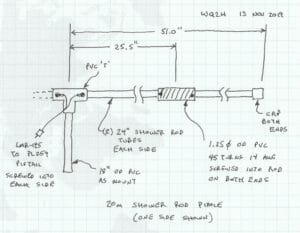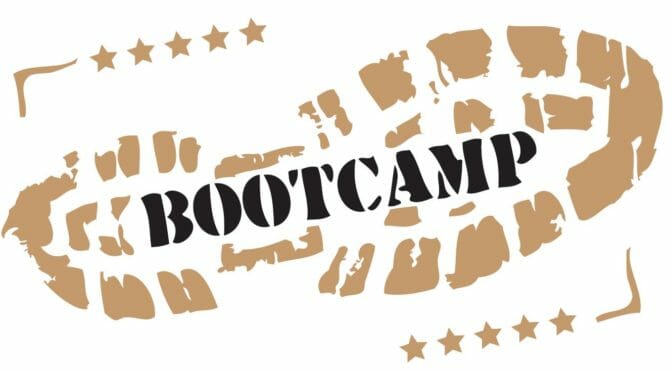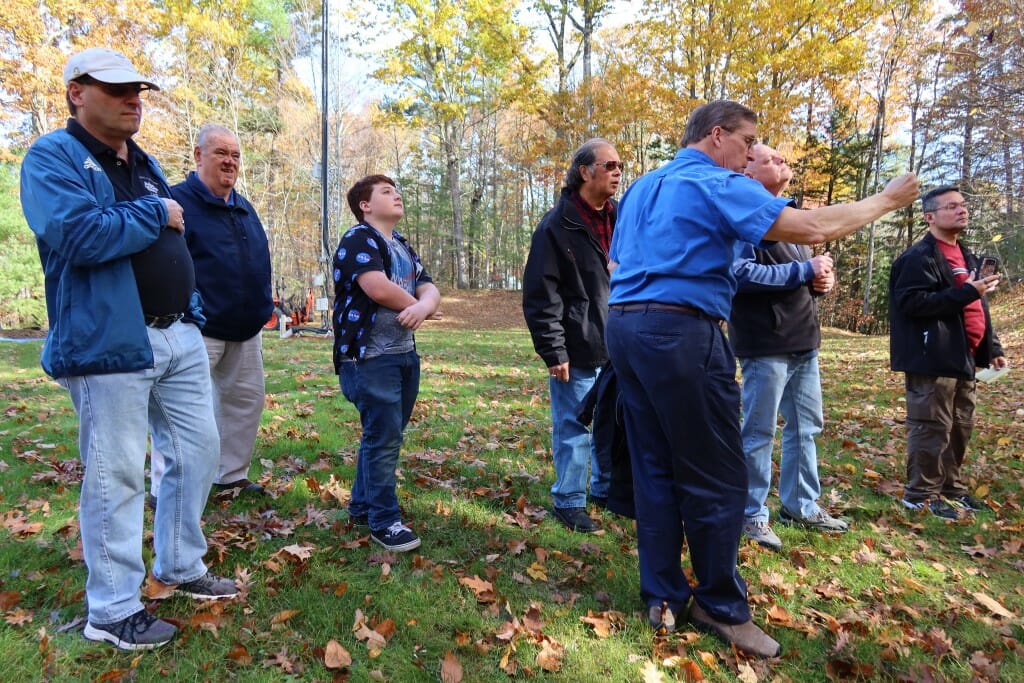If you’ve got a few old shower curtain rods hanging around – you can build a low-cost 20m shower rod dipole antenna. Additionally, if you add a tripod, and a matching transformer, and you’ll have a robust field deploy-able antenna. It can also be manually steered for better performance and searching for nulls.
This is the dipole that I used for the ARRL 2019 Field Day and was very happy with its performance. My preference this year was digital modes so I tuned the coils for the magical FT8 14.074 MHz. The original plan diagram is shown in Figure 1 and the coil calculator was used to design the inductors. Anything close to 19-20uH would work for this frequency (14.074 MHz.).
The Plan

Figure 1 – Mechanical plan
Using a PVC T, about 3 feet of 1.25″OD PVC pipe, four 24″ aluminum or plated steel shower rod sections, some 14 AWG stranded wire, and a handful of sheet metal screws you really can construct a pretty good dipole for 20m. I tested it mounted on a tripod as shown in Figure 2 and raised to 15-18′. The MFJ-907 transformer, or a torroid assembly similar to the 630m match, will make for an easy match transformer that could be mounted directly on the “T” section.

Figure 2 – Deployed Dipole on Tripod
On one end of the dipole I attached a short piece of kernmantle (nylon) rope which hung to the ground when the antenna was fully extended. This, and slipping the vertical PVC section over a mast tube, allows for turning the dipole for experimenting with nulls and increased Rx performance.
The Big Day
For the ARRL 2019 Field Day, I operated 1BNH using 5W maximum from near the top of Beech Hill in Dublin, NH. (Grid Square FN32xv) Radio was an FT-991 on battery using the built in ATU. Although the road to the summit was washed out this year from spring flooding, I was able to set up on a pretty good high point along Rt 137 just east of the Zig Zag trailhead.
QSO Results !
With only several hours of operating time out of the back of my Jeep I was able to FT8 QSOs with 13 stations in 6 unique call sign zones. Two of the most distant stations were the Halifax ARC (VE1FO) and the Northeastern Missouri ARC (W0CBL). Noteworthy is that while limited to only 5 Watts for transmitting, I could clearly hear many more stations (as many as 50) then I could actually QSO with.
Station List:
- 2019-06-23 09:48 W0RRC 20m EN34iv
2. 2019-06-23 09:20 K1HTV 20m FM18ap
3. 2019-06-23 07:59 W3MIE 20m EN91vp
4. 2019-06-23 07:48 W4XD 20m FM08jg
5. 2019-06-23 01:13 VE1FO 20m FN84ep
6. 2019-06-23 01:11 W0CBL 20m EN30tl
7. 2019-06-23 01:08 W1QV 20m FN31xi
8. 2019-06-22 19:43 W4HFH 20m FM18kt
9. 2019-06-22 19:31 K1BX 20m FN43ec
10. 2019-06-22 19:25 VA3BIC 20m FN02jv
11. 2019-06-22 18:39 K3NQT 20m FN00ra
12. 2019-06-22 18:38 VE3XF 20m EN94xj
13. 2019-06-22 18:33 VA3OBO 20m FN03bf
The project turned out a great portable antenna for 20m and the performance will definitely surprise you. A subsequent test at home using 100W on FT8, JT9-1, JT9-2, and WSPR, showed no signs of overpowering the antenna. Finally, if any readers have an interest and/or any other questions about this project feel free to contact me directly: [email protected].
73 – Jim, WQ2H / WK2XAH
References:
ARRL, (2015). The ARRL Antenna Book for Radio Communications, 23th Edition. The American Radio Relay League, Inc. Newington, CT
Electronics Notes (1997). Build an HF Ham Radio Dipole Antenna. Retrieved November 12, 2019 from: https://www.electronics-notes.com/articles/antennas-propagation/dipole-antenna/hf-ham-band-dipole-construction-80-40-20-15-10-meters.php
Andersen, S (2019 July 28). When a Dipole Doesn’t Hang in a Tree. NARS Article. Retrieved on November 12, 2019 from: https://www.n1fd.org/2019/07/28/unusual-dipoles/






